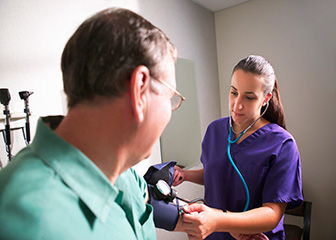
Assistants may update a patient’s medical file, fill out insurance forms, and answer telephone calls in a practitioner’s office.
In most states, there are no formal educational requirements for becoming a medical assistant. Most have at least a high school diploma. Many assistants learn through on-the-job training.
Education
High school students interested in a career as a medical assistant should take courses in biology, chemistry, and anatomy.
Medical assistants typically have a high school diploma or equivalent. There are no formal educational requirements for becoming a medical assistant in most states. However, some medical assistants graduate from formal education programs, and employers may prefer such training. Programs are available from community colleges, vocational schools, technical schools, or universities and take about 1 year to complete. These programs usually lead to a certificate or diploma. Some community and junior colleges offer 2-year programs that lead to an associate’s degree. All programs have classroom and laboratory portions that include lessons in anatomy and medical terminology.
Some states may require assistants to graduate from an accredited program or pass an exam or both to do advanced tasks, such as taking x rays and giving injections.
Training
Through on-the-job training, a physician or another medical assistant in the office may teach the new assistant medical terminology, the names of the instruments, how to do daily tasks, how to interact with patients, and other tasks that help keep the office running smoothly. An assistant also learns how to code both paper and electronic health records and how to record patient information. It can take several months for an assistant to complete training, depending on the facility.
Certification
Medical assistants are not required to be certified. However, employers prefer to hire certified assistants.
Several organizations offer certification. Some require the assistant to pass an exam, and others require graduation from an accredited program. In most cases, an applicant must be at least 18 years old before applying for certification.
The National Commission for Certifying Agencies, part of the Institute for Credentialing Excellence, accredits four certifications for medical assistants:
To be eligible for the CMA Certification Examination, an assistant must have completed a postsecondary medical assisting program accredited by either the Commission on Accreditation of Allied Health Education Programs (CAAHEP) or the Accrediting Bureau of Health Education Schools (ABHES) and passed the certification exam. For the other three certifications, no formal education is required to take the certification exam.
Important Qualities
Analytical skills. Medical assistants must be able to understand and follow medical charts and diagnoses. They may be required to code a patient’s medical records for billing purposes.
Detail oriented. Medical assistants must be precise when taking vital signs or recording patient information. Physicians and insurance companies rely on accurate records.
Interpersonal skills. Medical assistants need to be able to discuss patient information with other medical personnel, such as a physician. They often interact with patients who may be in pain or in distress, so they need to be able to act in a calm and professional manner.
Technical skills. Medical assistants should be able to use basic clinical instruments so they can take a patient’s vital signs, such as heart rate or blood pressure.













